SharePoint 2010 List View Blog Series: Part 1 – Introduction to the new List View

Hello. This is Greg Chan, a Program Manager on the SharePoint team. I am excited to kick-off a new blog series that will cover a wide spectrum of topics related to the new List View in SharePoint 2010.
What is a List View again?
Put simply, a List View is a view for displaying SharePoint list data. The concept of List View has been around since SharePoint v2. While there are other technologies being used for visualizing list data in different scenarios (e.g. Content Query Web Part), List View remains the default component for displaying list data in SharePoint 2010.
List Views can be spotted everywhere in SharePoint. They are used to display information such as your announcements, tasks and calendar schedules.
Examples of list views:

What’s the big change with List Views in 2010?
In 2010, we are introducing a component called the XSLT List View Web Part (XLV) that serves as the new default technology for displaying list data. This honor used to belong to the List View Web Part (LVWP), which was the default from SharePoint v2 to 2007. (Note: LVWPs are still supported in SharePoint 2010, but just not as widely used as the new XLV. )
The new XLV brings a ton of improvements to the SharePoint platform. This blog series aim to cover most of these areas.
What are the key benefits to the new List Views (XLV)?
Replacing the default technology for List Views required fundamental changes to the SharePoint platform. So why did we do it? Let me call out the high level benefits of the XLV:
- More Designer Friendly
- Rich customization support through SharePoint Designer while preserving browser UI experience
- Extensible and shareable custom styles
- Popular designer features such as Conditional Formatting.
- More Developer Friendly
- Uses standards-based XSLT instead of CAML
- Better documentation
- Easily extensible
- More End-User Friendly
- Enhanced user experience including Ribbon UI and new multi-selection model.
- Inline editing support
- More Robust Ways to Access Data
- Display enterprise data through Business Connectivity Services (BCS)
- Cross-web list views displaying data from another web
- Display list data joined from different lists
What’s coming up in the blog series?
Many people from different teams in the SharePoint family contributed to the new List View in SharePoint 2010. In this blog series, you’ll get a chance to hear from some of those area experts covering key List View topics.
Here are the topics that will be covered:
- Introduction to the new List View (you are reading it! :)
- List View – New User Experience
- List View Architecture
- List View Customization
- External Lists
- Conditional Formatting
- How to Share Your Custom List View Styles
- How to Create Custom Fields for the new List View
- Related Item View
- How to Create Views Displaying Cross-Web and Joined List Data
The order in which these topics will be published may change. We may also add or modify topics on this list. If there is any areas regarding List Views that you’d like to learn about and isn’t on this list, feel free to suggest them here.
Thanks for reading. I hope everyone is excited about the new List Views. Stayed tuned for more!
Greg Chan
